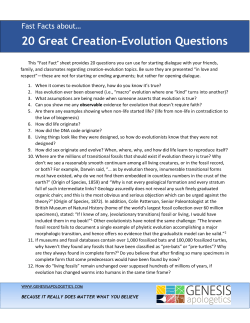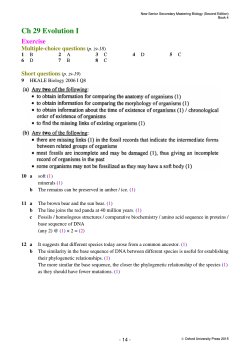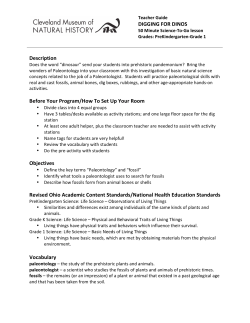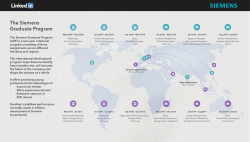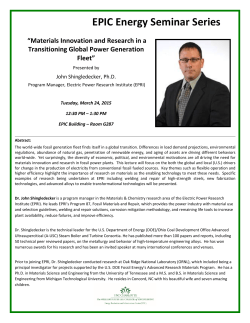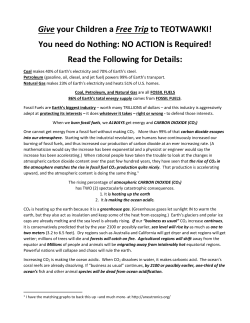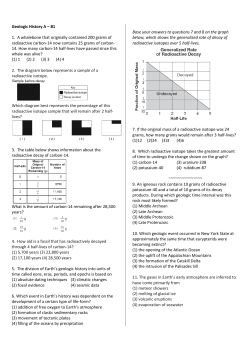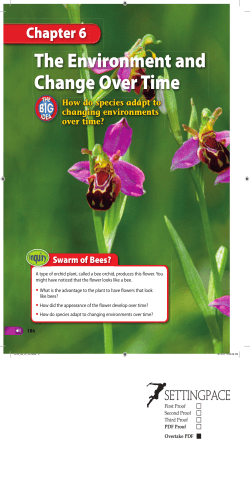
Worksheet Chapter 12.1-12.3 Chapter 12.1 – The Fossil Record
Worksheet Chapter 12.1-12.3 Chapter 12.1 – The Fossil Record MAIN IDEA: Fossils can form in several ways. In the spaces provided, write either the type of fossil being described or a brief description of how the fossil type is formed. Type of Fossil Description of Fossil Formation 1. Amber preserved fossil Organism trapped in tree resin that hardens after being buried. 2. Natural cast An impression is left in sediment, and minerals fill the impression in, recreating the original shape of the organism. 3. Trace fossil Record of the activity of an organism, such as a nest or footprints 4. Permineralized fossil Minerals are deposited around a hard structure and may replace the structure 5. Preserved remains Organism becomes encased in materials such as ice or volcanic ash, or immersed in a bog. Use Figure 12.2 in the textbook to fill in a sequence diagram that describes the process of permineralization. Fill-in the graphic organizer with the appropriate terms, definition and examples (examine pages 360-363 in the textbook to asset you): 12. What is the main purpose of both relative dating and radiometric dating? Both relative dating and radiometric dating are used to determine the age of a fossil or rock layer 13. What is the main difference between relative dating and radiometric dating? Relative dating is an estimate based on the fossil or rock layer’s location, whereas radiometric dating determines a fossil’s absolute, or actual, age. 14. How is the radioactive decay of an element used to determine the age of a rock layer? As an isotope of an element decays, it can transform into a different element. Because the decay rates of many radioactive isotopes are known, the proportion between an original element and its product isotope allows scientists to determine when that rock layer was formed 15. Look at the graph above illustrating the Half-life. Determine what percentage of carbon-14 remains in a sample after two half-lives? 25% Vocabulary Check (A) Relative dating (B) radiometric dating (C) isotope B 16. Measures the actual age of a fossil C 17. Most elements have several of these D 18. Measure of the release of radiation A 19. Infers order in which groups of organisms existed (D) half-life Chapter 12.2 – The Geological Time Scale MAIN IDEA: The geologic time scale divides Earth’s history based on major past events. Index fossils are another tool to determine the age of rock layers. 1. How are index fossils used to determine the age of fossils or rock layers? Index fossils are used as markers to identify a particular layer of rock wherever it is found. 2. What four characteristics are best for an index fossil to have? 1. 2. Easy to identify 3. 4. Existed for a relatively brief time. The names of eras come from early ideas about life forms preserved as fossils. Provide the meaning of the following names of eras: 3. Paleozoic Ancient Life 4. Mesozoic Middle Life 5. Cenozoic Recent Life 6. How is the geologic time scale a representation of the history of Earth? The geologic time scale organizes Earth’s history by major changes or events, using evidence from fossil and geologic records. Chapter 12.3– The Origin of Life 1. The origin of life still remains a puzzle. Earth was very different billions of years ago, however most scientists agree on two points about Earth’s origins. What are they? (1) Earth is billions of years old, and (2) the conditions of the early planet and its atmosphere were very different from those of today. Fill-in the Web with the descriptions of the early Earth atmosphere Several sets of hypotheses propose how life began on Earth. Examine the table below, in the column on the left labeled “hypothesis,” write the hypothesis from the readings about how life began on Earth. In the column labeled “proof,” list the evidence that supports the hypothesis. Finally, answer the question at the end of the table. Hypothesis Proof I. ORGANIC MOLECULE HYPOTHESES 9. Miller-Urey Demonstrated organic compounds could be made by passing electrical current (to simulate lightning) through a closed system that held a mixture of gases (to simulate the early atmosphere). 10. Meteorite hypothesis More than 90 amino acids have been identified from this meteorite II. EARLY CELL STRUCTURE HYPOTHESES 11. Iron-sulfide bubbles hypothesis Simulated in the lab, making a chimney structure with compartments that could have acted as the first cell membranes. 12. Lipid membrane hypothesis Spontaneously form in nature and could have formed the f irst true cell membranes. III. RNA AS EARLY GENETIC MATERIAL 13. RNA world hypothesis Ribozymes are RNA that can catalyze their own reactions without the additional enzymes that are needed for DNA replication.
© Copyright 2026


